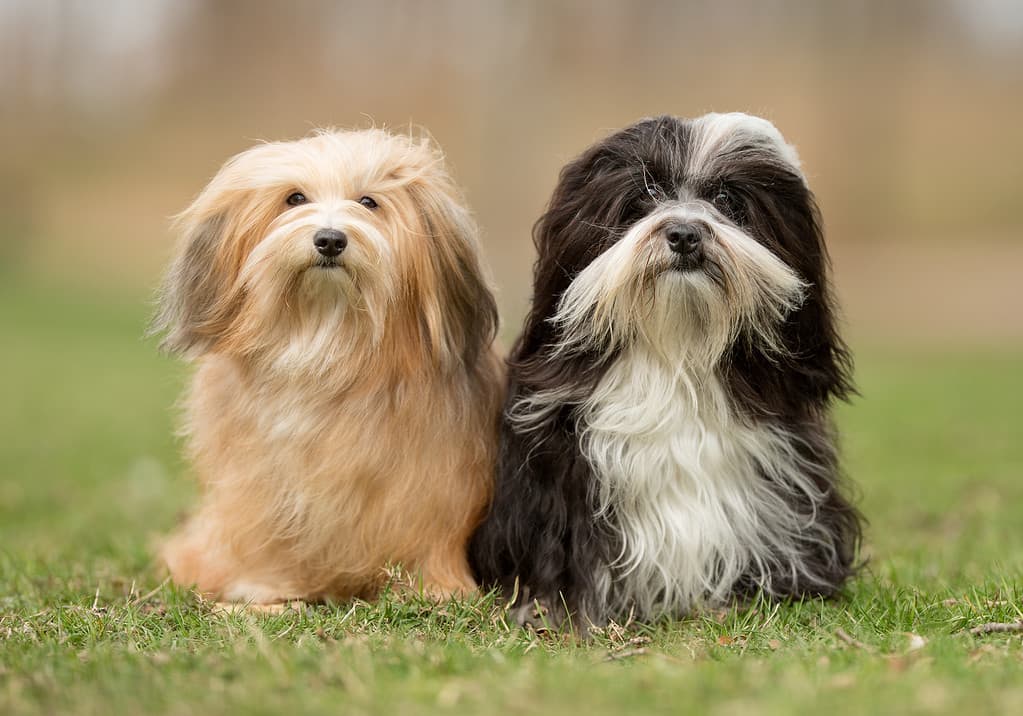Havanese, with their cute, floppy ears and long, fluffy hair, are the only dog breed native to Cuba. It’s hard not to fall in love with their deep brown eyes and soft fur. But before you bring home your fluffy friend, you’ll need to decide whether to pick a male or female Havanese. We’re here to tell you the 5 key differences in male and female Havanese.
Comparing a Male and Female Havanese
| Differences | Male Havanese | Female Havanese |
|---|---|---|
| Temperament | More patient and tolerant, but high attention needs and possible jealousy. | Less patient and more aggressive, but more independent and better with other animals. |
| Reproductive Roles | Most fertile around 12 to 15 months, as early as 5 months. | Fertile during their first heat, which can occur between 6 and 15 months. |
| Health Considerations | Males live to around 15 years and require regular grooming to stay healthy. | Females live approximately one year longer than males. |
| Physical Traits | 8 to 13 pounds and around an inch taller than females | 7 to 12 pounds |
| Training | Generally easier to train, but slower learners. | Can be stubborn, but are quick learners. |
Key Differences Between a Male and Female Havanese
The key differences between male and female Havanese are their temperament, reproductive role, health considerations, physical traits, and responses to training.

These adorable pups can come in many different colors.
©Bigandt_Photography/iStock via Getty Images
Male vs. Female Havanese: Temperament
The biggest difference between male and female Havanese is their temperament. While these small dogs don’t have size differences based on sex, they certainly do have different personalities.
Male Havanese are usually more patient and tolerant, making them a great choice for families with kids. However, they can require a bit more time than their female counterparts. If you have plenty of time for training and a large family, a male Havanese might be the better choice for you. They are pretty social and love to please their owners, but their high attention needs can lead to jealousy around other pets. Male Havanese are not nearly as accepting of other animals as the females are.
On the other hand, if you have older children or other pets, you might want to go with a female Havanese. They aren’t as playful as the males and can be more aggressive, so they do better in a household with older children. While female Havanese require the same attention level as males, they aren’t as clingy and are more independent. Their lack of jealousy and acceptance of other pets make female Havenese a great choice for households with cats or other dogs.

A male Havanese may be a better choice for homes with small children because they are more patient.
©Dorottya_Mathe/iStock via Getty Images
Male vs. Female Havanese: Reproductive Roles
Male Havanese are most fertile around 12 to 15 months of age but can sire puppies as young as 5 months. Sexually mature males can develop some unwanted tendencies including aggression, territorial marking, and roaming.
Female Havanese become fertile during their first heat, which can take place anywhere between 6 and 15 months. The female can get pregnant anytime during the first heat, and her fertility usually lasts for two to three weeks.
If you aren’t planning on having puppies, it’s highly recommended to spay or neuter your dog. Both sexes will benefit from the procedure, as it can prevent negative behaviors. The best time to spay or neuter your pet is after they have reached full maturity. This is usually after the first heat or after the dog reaches 12 months.

Unless you want puppies, you should definitely get your Havanese fixed!
©Dorottya_Mathe/iStock via Getty Images
Male vs. Female Havanese: Health Considerations
Both males and females have pretty long expected life spans for dogs. As in humans, female Havanese will usually live a bit longer than the males, but it’s not a notable difference.
In terms of health problems, there are no significant issues that impact one sex more than another. Both sexes need regular grooming to keep them healthy. The breed is susceptible to hip dysplasia and eye infections, but Havanese will regularly live for 15 years. Females will generally live around a year longer than males.

Havanese dogs typically don’t experience many health issues, but hip dysplasia is the most common.
©arlutz73/iStock via Getty Images
Male vs. Female Havanese: Physical Traits
Male Havanese are generally larger in size and weight than females. They range from 8 to 13 pounds while females range from 7 to 12.
Male Havanese are also around an inch taller than their female counterparts.

Male Havanese are usually an inch larger and a pound heavier than females of the same age.
©Dorottya Mathe/Shutterstock.com
Male vs. Female Havanese: Responses to Training
The males are usually a bit easier to train than females because they are less stubborn. They’re naturally a bit more active than the females, so they have more energy for training. In general, male Havanese have more of a desire to please their owners, making them better listeners.
Female Havanese tend to have better focus than males, but they can be much more stubborn. They also tend to be quicker learners, paying more attention to training than male Havanese.
One training issue for both sexes is housebreaking. Potty training is difficult for Havanese and often takes many months and a lot of positive reinforcement. One reason for this is that Havanese are a toy breed, so they have smaller bladders than other dogs. Expect to spend around 6 to 8 months before you can rely on your pup being potty trained.
The photo featured at the top of this post is © mheim3011/iStock via Getty Images
Ready to discover the top 10 cutest dog breeds in the entire world?
How about the fastest dogs, the largest dogs and those that are -- quite frankly -- just the kindest dogs on the planet? Each day, AZ Animals sends out lists just like this to our thousands of email subscribers. And the best part? It's FREE. Join today by entering your email below.
Thank you for reading! Have some feedback for us? Contact the AZ Animals editorial team.






